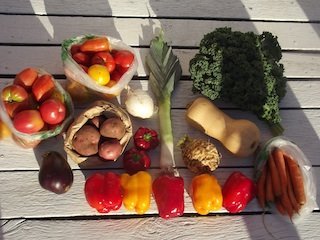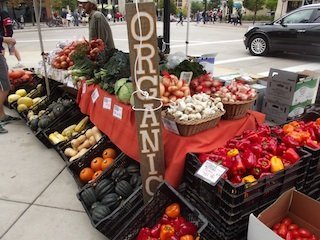
The farm is falling down. With each gust of wind, each cool night, and each shortening day. The plants know that their time is limited and are all giving their last surge toward making seed to propagate their species, sending down roots deeper in the softened soil, and ripening their fruits and seeds as efficiently as they can to ensure the legacy of their kind.  This week’s bounty!
This week’s bounty!
I believe that we live in one of the most beautiful places on earth. The fall colors bring our hillsides to life and glorify our forests. The scenery is so spectacular that people come from near and far to witness this short-termed phenomenon. The colors enliven our experience of fall and make us all want to pick a pumpkin, drink a mug of warm, mulled cider and put on a wool sweater for a walk down a country road. The weather is fine folks, c’mon out and see!
The vegetable fields are slowing. As we near our final few weeks of Summer Share deliveries we see the tremendous amount of work that still needs to get done on the farm. We see several beds of potatoes, carrots, beets, parsnips and sweet potatoes that still need harvesting before the ground freezes. We have black plastic that needs to get pulled out of the fields and trellising that needs to get taken down. We will still be hard at work in the fields for a good month even after CSA deliveries have ended.
The cool breeze and the red leaves are a welcome sensory experience for a tired farmers body. We have been tapping into our energy reserves each morning that we rise, reminding ourselves that we DO love our work. We are thankful that the sky is dark by 7:30pm and that we cannot squeeze another hours work into the day. The family is gaining focus and the couch is looking quite comfortable. Hooray for Fall!
Butternut Squash- This hard winter squash is amung the favorites by squash lovers. Cut your butternut in half lengthwise, scoop the seeds out and bake it face down in a pan with a little water for about an hour. When it’s done cooking add plenty of butter and enjoy! Will keep on your counter for a few months.
Red Potaotes- Freshly dug on Monday morning, these new red potatoes look quite nice. Despite a generally poor potato harvest on our farm this year, they keep coming steady and strong.
Carrots- Another nice bag of carrots for your everyday use.
Mixed Tomatoes- Still an impressive amount of tomatoes coming from the garden. They’re really slowing down now, so we can expect a smaller giving of tomatoes next week. Remember to allow them to ripen outside of refrigeration before you transfer them to the fridge. You could just cut up your ripe tomatoes and freeze them if you’re not up for the canning experience.
White Onion- Another nice oinon for your everyday use.
Eggplant– I promise you, this is the final week of eggplant. Some will be happy, some will be sad. Now we have to wait another 10 monthes before we can eat fresh, local eggplant again. Hope you got your fill!
Celeriac Root- The most unusual item in the box this week. Celeriac roots are specially cultivated so that the root of the celery plant grows into a nice sized bulb instead of the stalks. Usually we like to give them with their tops on so that you can use their celery-looking tops in cooking, but this year they were browning too much and we elected to just chop them off. Peel your celeriac root with a pearing knive and boil and mash it with poatoes for a celeriac mashed potato dish (see recipe below). Once cooked it has a potato consistency, but a celery flavor with less starch than a potato. It can also be grated raw into a slaw, or grated with potatoes for a celeriac hash brown recipe.
Leeks- Leeks are definately a sign of fall. We started these little buggers from seed in February and watered and transplanted and weeded and weeded and weeded them. Alas, Whalla! Here they are on your dinner table. Use leeks like an onion or feature their flavor in a potato-leek soup.  Our booth at the Madison Farmer’s Market on the Square. Come out and see us on Satruday morning!
Our booth at the Madison Farmer’s Market on the Square. Come out and see us on Satruday morning!
Sweet Pepper Mix- Still an outstanding 7 peppers per member this week. We de-seeded and cut up and froze several bags of peppers for the winter. Use them in January to top your pizzas, make fajitas or to bake in a quiche.
Green Curly Kale- A nice bunch of kale to add a little greens to your diet. Kale can be re-hydrated and made perky again if you trim their stems and soak them in water for 10 minutes. They should perk up and look like they’ve just been picked.
Mashed Potatoes with Celeriac Root